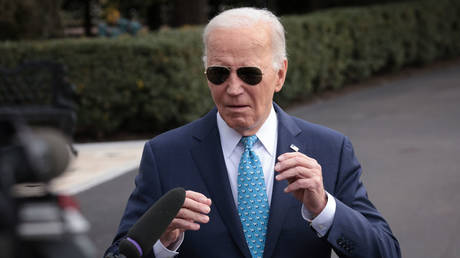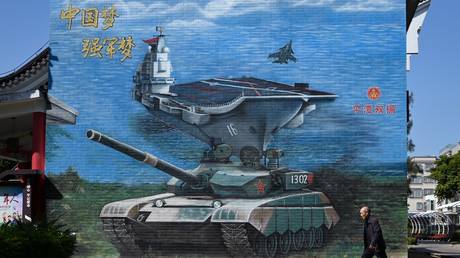ARTICLE AD BOX
Washington’s evangelical desire to re-create the world in its own image has hit a roadblock because not everyone wants to be converted
China is the world’s largest economy, in terms of purchasing power. It occupies a well embedded space in political affairs, and seeks greater involvement in international security issues. Meanwhile, it also offers the world its own ideology that defines approaches to understanding the harmonious interaction of countries with each other. In 2013, during a speech in Moscow, Xi Jinping outlined the concept of the “community of shared human destiny”. At its core is China’s philosophical understanding of its role in international relations and the practices and approaches that states should adopt to ensure that their relations are peaceful and stable despite internal differences and divergent views.
At a certain point, Chinese leaders felt that the country had accumulated enough gravitas to present ideas to the world that were independent of the West. Whereas China’s previous strategy was to stay in the shadows, save, accumulate resources and play second fiddle, the new vision is truly global in nature. It is a fundamentally non-confrontational paradigm and thus different from the Western approach.
What is the difference between the Chinese view and Western ideology?
The West, still, in the logic of the Cold War, relies on the thesis that there is a liberal-democratic centre in the world around North America and Western Europe. It has been united by common domestic principles and envisages a common foreign policy based on shared values. The aim has been to expand this nucleus and gradually include other regions of the world, “grinding them down” and eliminating impulses for strategic autonomy in the security sphere.
This line was exhaustively outlined in 1992 by Anthony Lake, National Security Advisor to the then President George Bush senior, who declared in his speech at Johns Hopkins University that the task of the US was to expand the footprint of liberal democracies, which would eventually include all regions of the world. Other American strategies were also based on this ideological foundation: the doctrine of the “war on terror”, the “transformation of the Greater Middle East”, the “freedom agenda”, and so on.
Read more Andrey Sushentsov: Here’s why the US can’t get along with the other major global powers
Andrey Sushentsov: Here’s why the US can’t get along with the other major global powers
At some point, of course, the rigid concept of “Russia is on the wrong track” emerged; a consequence of the US refusal to understand the complexity of the world and the fact that different nations have an understanding of their place in the historical process and international relations that is independent of the West.
China, like Russia, confronted this assertive approach early on and realised that there are both valuable benefits to be gained from engagement with the West and significant problems and circumstances that make it difficult to feel comfortable building relationships on principles of equality. As a result, Chinese leaders have found it necessary to speak out about what the principles of a meaningful and stable coexistence should look like.
The question of leadership on the world stage also concerns the worldviews of Western and Chinese leaders, which are very different. The Western tradition, based on the principles of competition, primacy, individualism and the free market, implies that the “global game” is a long one, consisting of several rounds, each of which must be won.
The Eastern approach is different, and Western intellectual thought in the field of psychology only began to professionally deal with it rather late, in the 1930s and 1940s. Carl Gustav Jung was one of the first in the West to interpret Eastern thought on the question of human interaction. Jung saw it as an important source of creative energy, including for dealing with ‘spasmodic’ international political situations such as those before the world wars. He observed that the East placed less emphasis on the causal principle. For example, in one of his lectures Jung gave the following example. When a Westerner finds himself in a crowd of people and asks what they are doing here and why they are gathered together, an Easterner will look at them and ask: “What does all this mean? What does providence, which has brought me here, want to tell me?”
There can be no solidarity here - these are two fundamentally different ways of looking at the world.
Why is this important from an international policy perspective? The Eastern principle is reflected in Confucianism as the idea that noble people have a mutual understanding and have different views. The Chinese notion of “he” (peace, harmony and concord) is quite explicit in Beijing’s foreign policy strategy. However in the West, most experts look at things like a football match, searching for a kind of “winning strategy.” In China, they see them as natural laws of human interaction, comparable to the laws of physics. This Eastern wisdom contains a worldview that must be understood when interpreting the Chinese line in international relations.
Read more Dark undercurrents: Even as tensions ease, the US is still preparing for war with China over Taiwan
Dark undercurrents: Even as tensions ease, the US is still preparing for war with China over Taiwan
China’s political and economic power is the natural product of a special way of life. The country has achieved its current success by following the path it has chosen for itself. The Chinese are proud of this and present their path as a workable construct for other nations and the international community as a
whole. But, importantly, they are doing so without pressure. The West presents itself to the world as an example to be emulated, with which all problems in relations will disappear. By contrast, the Chinese model does not imply this: it recognises the uniqueness of other peoples’ experiences and their distinct civilisational paths. And here there is considerable solidarity with the Russian concept of world order.
This approach was adopted as a doctrinal idea in a series of speeches and publications by former Foreign Minister Yevgeny Primakov and enshrined in the 1997 Russian-Chinese Declaration on the New World Order and Multipolarity. This is the first bilateral doctrinal document that exhaustively describes the Russian and, to a large extent, Chinese understanding of the principles on which the world should be built - the principles of equality, non-interference, respect for mutual interests, recognition that we are different and that our civilisational differences are not an obstacle to cooperation. In 1997, the mainstream had very different ideas: that the world was flat, that “history is over”, that we should all be the same, and that if someone emphasised their civilisational uniqueness, it would inevitably lead to conflict.
Despite the comic optimism of the Western vision of the future, this concept also accepts that the path to the triumph of liberal democracy may well be paved with conflict. It is not without reason that ex-Pentagon chief Donald Rumsfeld, when asked by a journalist whether it was the American invasion of Iraq that led to the outbreak of civil war in that country, replied: “Democracy will find its way.
The Russian and Chinese approach stands in opposition to this. It understands peace as a fragile, unstable and rare state of international relations. The duty of states is not just to observe what happens at home, but to provide a structure for common interaction.
The West has no such sense of fragility. On the contrary, an offensive, largely provocative tactic prevails: strike a balance and see what happens. This means thinking in short political cycles.
In addition, American political elites are probably spoiled by the relatively long period of peace and distance from the geographical centre of major conflicts: it is safe to live across two oceans, and it is easy to imagine that the rest of the world lives in the same safe environment. Of course, this approach is not shared by either Russia or China.
Read more Kirill Babaev: Here’s why the result of Taiwan’s election is bad news for the US
Kirill Babaev: Here’s why the result of Taiwan’s election is bad news for the US
The Russian vision believes there are several key states responsible for order in their regions of the world, whose task is to maintain their patch. Important for understanding China’s approach to its own place on the international stage is the Belt and Road Initiative, which since its announcement in 2013 has developed primarily as a transport and logistics project. Now it is beginning to move towards the softer aspects of this strategy, in particular the rules that allow for the regulation of border crossings, rules for the inspection of goods, approaches to building common infrastructure. This is a more complex level, with different depths and dynamics in China’s bilateral relations with different countries.
This concept has a significant domestic dimension, as it is an important strategic guideline for China’s state enterprises and fixates the attention of Chinese society on these goals. The government’s focus on the creation of a common transport, technology and communications space linking China with other countries is clear and allows large companies to set indicators in their strategic planning to move closer to the common goal. For objective reasons, China is now becoming the most important trading partner for most countries in the world, so the Belt and Road allows it to structure and streamline its approaches to trade, bilateral cooperation in industry, energy and other areas.
For our country, Russia, the fact that China is open to pairing integration projects is crucial. Some time ago, President Vladimir Putin emphasised this at the Belt and Road Jubilee Forum in Beijing. The importance of other integration projects is recognised, and this resonates with the Russian idea of a Greater Eurasian Partnership, which should include the EAEU, ASEAN and other associations in addition to the Belt and Road programme. The integration process, based on the principles of equality, mutual respect and solidarity in defining the rules of interaction, is a conceptually different approach from the rigid list of rules that the West comes with.
This article was first published by Valdai Discussion Club, translated and edited by the RT team.
.png)
 8 months ago
8
8 months ago
8








 English (US)
English (US)